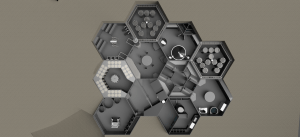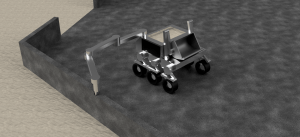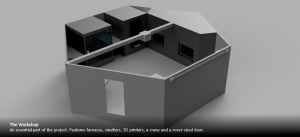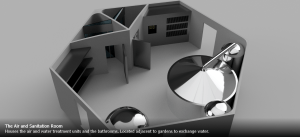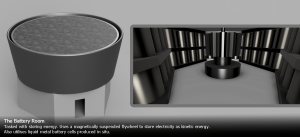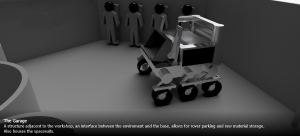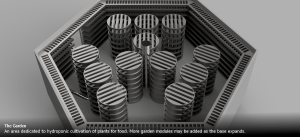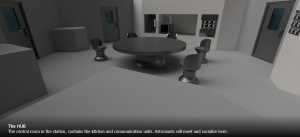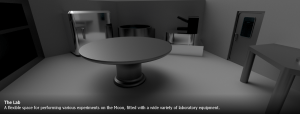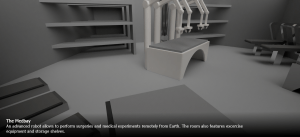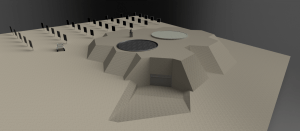Moon Camp Pioneers Gallery 2020-2021
In Moon Camp Pioneers each team’s mission is to 3D design a complete Moon Camp using Fusion 360. They also have to explain how they will use local resources, protect astronauts from the dangerous of space and describe the living and working facilities.
Team: Space Hive
Publiczne Liceum Ogólnokształcące Uniwersytetu Łódzkiego im. Sprawiedliwych wśród Narodów Świata Łódź Poland 16, 15
External viewer for 3d project
|
Project description
Our base is the foundation of a true self-sustainable colony on the moon. When designing it, we focused on the greatest possible self-sufficiency and functionality of each element, while remembering the most important, i.e. the comfort of the astronauts staying in it. Additions, such as an artificially controlled day and night cycle, or the presence of plants in rooms, should reduce stress among astronauts and take care of their mental health. The base is designed for a minimum of 4 people, but with a larger number, the distribution into four-person residential modules may contribute to the development of a sense of small communities, which will facilitate work and division of duties. Both the location and the equipment of the base make it possible to carry out numerous experiments and efficiently conduct further space expansion. |
|||
|
Where do you want to build your Moon Camp?
We’ve decided to build our moon base on the south pole of the moon, on the rim of the Shackleton Crater. According to the best of our knowledge, there is water ice and other volatiles in it. The potential presence of water would solve the problem of acquiring it and would not require its costly delivery from the Earth. Placing our base on its rim would also massively simplify the problem of providing the base with electricity. On the edge of the crater, solar energy arrives almost continually, so there would be a possibility of practically continuous conversion of solar energy into electrical energy with the use of solar panels. It also means that there will be less temperature variation,which might be dangerous to components susceptible to thermal expansion. According to topographic maps of the area, it has a slope of about 6-7 degrees, reflected in our model. How do you plan to build your Moon Camp? Describe the techniques and materials you would use.
First, a scouting rover will be deployed. Once it has found a suitable location it will prepare a flat area on which the Workshop part with the rovers, solar panels and 3D printers inside will land. The rovers would be autonomous, however the Earth-Moon communication delay is short enough for a human to effectively control a rover in case of a problem. Initially the Workshop will serve as a base of operations, being fitted with batteries and able to produce spare parts for the robots. We plan to 3D print the base’s roof, walls and most of the furniture using lunar concrete, the main component of which is lunar regolith, a resource abundant on the Moon’s surface. The base will be made up of hexagonal rooms in order to maximize material use efficiency and facilitate easy expansion. The interior of the rooms would be coated with a layer of synthetic rubber, allowing them to be filled with an atmosphere. The pressure of the air inside would be enough to support the weight of a ~4-meter thick regolith radiation shield. In order to minimize the amount of dust that the inhabitants may bring inside the base, the spacesuits would never directly enter the base, instead allowing the crew to enter them through hatches on the back. After the printing process is done, other necessary gear can be brought from Earth together with the arriving astronauts and set up on the lunar surface. The environment on the Moon is very dangerous for the astronauts. Explain how your Moon Camp will protect them.
The environment on the Moon is very dangerous, so one of our priorities is to ensure the full safety of the astronauts who are on the base. One of the main dangers waiting for people on the Moon is cosmic radiation, which is up to 200 times stronger than on Earth. However, it has been proven that there are lower levels of radiation near large craters, so the location of our base in Shackleton Crater will partially solve this problem. Additional protection will also be provided by the base walls, which are about 4 meters thick and made of lunar soil. These walls will also provide protection from micrometeorites and the extremely low temperatures found on the moon. Explain how your Moon Camp will provide the astronauts with:
|
|||
|
Water
|
Food
|
Electricity
|
Air
|
|
As a baseline, the ISS has a 2000L water tank for a six-person crew. However, our base will also use water for plant, animal and microbial cultivation and water electrolysis. To accommodate this demand our base will have an about 30 000L max water storage capacity – this will also facilitate further base expansion. Astronauts will bring some water with them, but most of the water will be sourced by rovers from nearby volatile deposits in the Shackleton Crater. Exhaled water will be recaptured by the air treatment unit and put back into the water supply. Urine will be filtered and reintroduced back into the tanks. All biowaste will be recycled for use as plant fertilizer and animal or microbe food when possible. |
Hydroponic cultivation will play a key role in obtaining food at the station. Hydroponic gardens will use LEDs with selected light wavelengths (i.e. mostly red) to minimise energy waste. Each person going to the Moon will have a predetermined, individual diet that covers their total caloric needs, as well as macro and microelements. According to such data, it will be possible to plan the proportions of cultivated plants in advance. In addition, we plan to acquire protein in the form of the so-called “cultured meat”. This technology is becoming more and more advanced, so we would like to use it in our base. Initially, the stock of stem cells would be brought from Earth, but over time, when the breeding of animals in the base is mastered, cells would be taken directly from them. By providing astronauts with access to wholesome meals that look as similar as possible to those eaten on Earth, we will be taking care of both their physical and mental health. |
Because our base is located on the part of Shackleton’s rim that is a “peak of eternal light” it will receive near-continuous solar radiation. As a result it will be able to sustain itself solely on solar power most of the time. However, power storage is crucial for high draw operations such as water electrolysis or in situ metal refining, also there are still nights which might last up to seven earth days. To address these issues the base will possess a number of energy storage solutions. Initially it will utilise light lithium-ion batteries and solar panels shipped from earth, later expanding with solar panels and liquid metal batteries constructed in situ. If constructing batteries proves to be infeasible, it might be fitted with large flywheels made with compressed regolith suspended via spin-stabilized maglev (the lack of atmosphere and low gravity make them much easier to operate than on Earth) |
Oxygen will be sourced from a number of processes. It will be a product of photosynthesis in the hydroponic gardens and a side product of metal oxide refinement via electrolysis. It might also be obtained from water electrolysis, but without an oxidizer the produced Hydrogen would be useless as a fuel. Since Carbon is a limited resource on the Moon, we will try to recycle as much CO2 as we can with photosynthesis. Inert gases, such as Nitrogen and Argon do not undergo any reactions so they might be used indefinitely provided no leaks occur. Water vapour produced by breathing will be captured and reintroduced into the water supply. |
|
Explain what would be the main purpose of your Moon Camp (for example: commercial, scientific, and/or tourist purposes).
First groups of astronauts sent to our base will try to familiarize themselves with the environment on the moon and conduct the most necessary scientific experiments. A major role in research will be the study of the reaction of people and animals to long-term stay on the moon as well as improving agricultural technology, telecommunications, and energy production, which can later be used on Earth. The base will also hopefully serve as an interplanetary hub, able to supply ships venturing to Mars with food and fuel. In the future, it could be a source of cheaper material for building large space installations and ships because of lower gravity. The flexibility of our base also allows the opportunity to expand the base and deviate from its original goals, focusing on more commercial opportunities, tourism, or large colony development. |
|||
|
Describe a day on the Moon for your Moon Camp astronaut crew.
When designing our space base, we found that the most efficient work system would be to personalize each astronaut’s daily schedule. This will facilitate the performance of specialized tasks and allow at least 2 people to stay awake, even in the case of a small crew. The plans for each day will initially be sent from the control center on Earth, and as the base develops, individual crew members will be responsible for making them for the rest of the group. At the beginning of the day, after getting ready for work, astronauts go to check the latest information on the monitor, which at the same time briefs them about their current duties, tailored to their specialty. The task of some will be to conduct research, experiments, and work in the laboratory, others will deal with the care of animals and cultivation of plants, while others will control the work of the modules of the base, repair current damage and maintain the technical condition of rovers. After reviewing their schedules, astronauts will head to the community room to eat a personalized – like all other meals, breakfast. The astronauts then tackle their assigned tasks. After completing their first tasks, the astronauts go to a gym connected to the medical room and there they are introduced to their personal training plan for the current day. After their workout, the astronauts again head to the common room, for their second meal. It will be very important to plan the day so that the astronauts’ meal times overlap as much as possible, of course, some will have lunch and others dinner. However, the point is to ensure human contact and build a sense of community among the astronauts. After lunch, if the current situation permits, the astronauts have free time. They can entertain themselves with video games, virtual reality, books or music. They might also call their families, or spend some time with other astronauts or animals. Then they return to their duties for some time until the evening. At the end of the day, they go to dinner and to their bedrooms. This is what an average, quiet day looks like at our lunar base. |
|||



